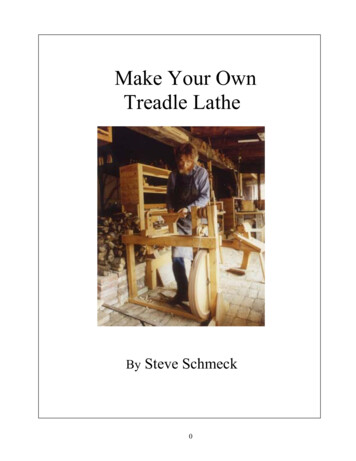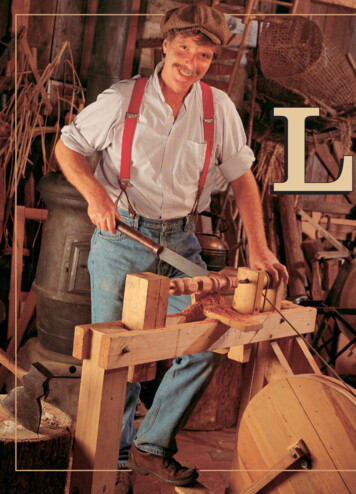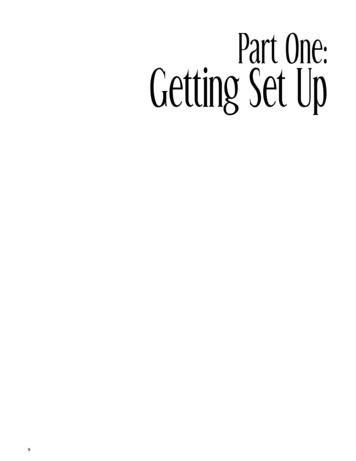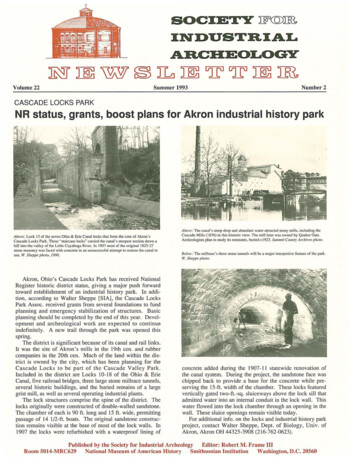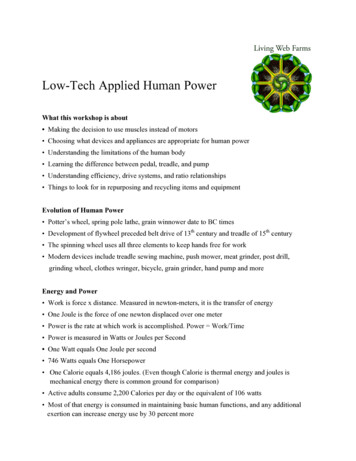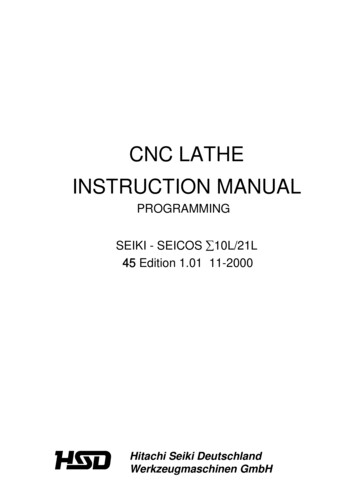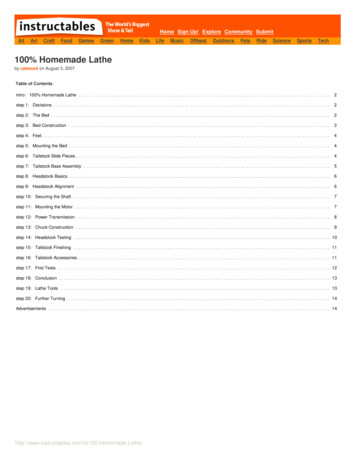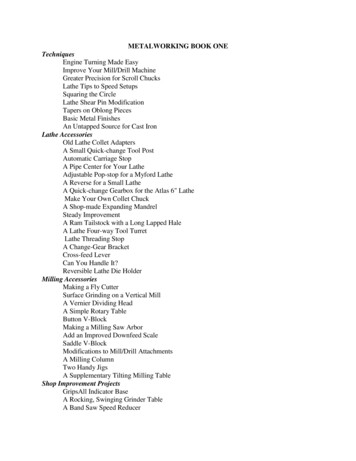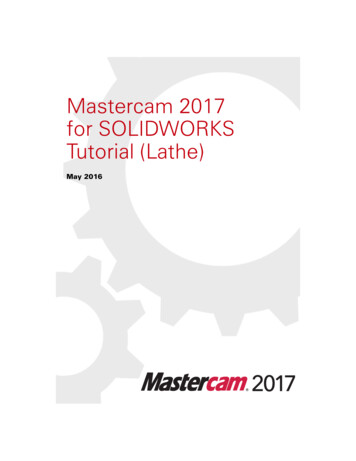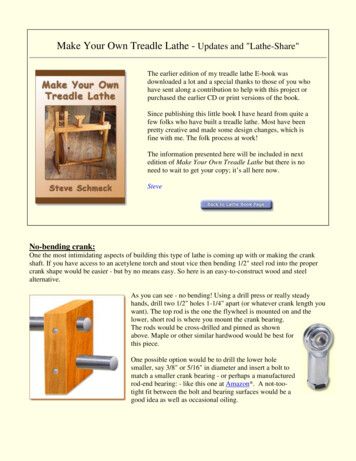
Transcription
Make Your Own Treadle Lathe - Updates and "Lathe-Share"The earlier edition of my treadle lathe E-book wasdownloaded a lot and a special thanks to those of you whohave sent along a contribution to help with this project orpurchased the earlier CD or print versions of the book.Since publishing this little book I have heard from quite afew folks who have built a treadle lathe. Most have beenpretty creative and made some design changes, which isfine with me. The folk process at work!The information presented here will be included in nextedition of Make Your Own Treadle Lathe but there is noneed to wait to get your copy; it’s all here now.SteveNo-bending crank:One the most intimidating aspects of building this type of lathe is coming up with or making the crankshaft. If you have access to an acetylene torch and stout vice then bending 1/2" steel rod into the propercrank shape would be easier - but by no means easy. So here is an easy-to-construct wood and steelalternative.As you can see - no bending! Using a drill press or really steadyhands, drill two 1/2" holes 1-1/4" apart (or whatever crank length youwant). The top rod is the one the flywheel is mounted on and thelower, short rod is where you mount the crank bearing.The rods would be cross-drilled and pinned as shownabove. Maple or other similar hardwood would be best forthis piece.One possible option would be to drill the lower holesmaller, say 3/8" or 5/16" in diameter and insert a bolt tomatch a smaller crank bearing - or perhaps a manufacturedrod-end bearing: - like this one at Amazon*. A not-tootight fit between the bolt and bearing surfaces would be agood idea as well as occasional oiling.
Another view:Another crank option:If you look lower on this page you will see some of the many lathesinspired, more or less, by my lathe book. Check out the flywheel drivemechanism on the blue lathe built by Jim Albro. I love that some folkshave come up with some very creative solutions when building theirlathe.By supporting the flywheel from only the left side (the shaft doesn't goall the way through to the second upright) Jim was able to totallyeliminate the need for a regular crank. It would be possible to haveseveral different 'gear ratios', thus be able to change the speed/torqueratio, by changing the distance the bolt at 'A' is from the center of theflywheel. Good bearings at 'B' and in the hub of the flywheel shouldensure that the pivot and flywheel worked smoothly.I have not tried this system but am intrigued by its simplicity andpotential for adjustability.
Headstock layout details:Here is some additional information on how to set up the headstock. My apologies for not having coveredthis very well in the book. The drawing below shows how I put my lathe's headstock together.In the book I discuss boring bearing recesses and shaft clearance holes in the headstock uprights prior toassembly. Here you can see the specifics of the layout. I have found the pin on the left to be needed onlyif there is a lot of end-play in the shaft. The brass bushing used as a spacer between the drive center andthe bearing on the right pretty well positions the shaft. I suppose that in heavy use pressure from thetailstock could overpower the bearings a bit (they aren't designed for much lateral loading) in which casethe pin, and a dab of grease, would be a good idea.The pulley spacers are short sections of metal tube sized to position the pulley right above the groove inthe flywheel. If your pulley has good set screws these tubes are not necessary.Here is a photo of my old Shopsmith drive center:It is held to the drive shaft by that set-screw. You might want to plan ahead and order this part early sinceI just noticed (March, 2017) that it may be a 'special order' item now. I have not found any source otherthan Shopsmith* for this type of drive center.My drive shaft is only 1/2" in diameter and the drive center is designed for a 5/8"shaft so I made up a simple bushing out of a short piece of PVC plastic pipe:The hole in the side is for the set-screw.
Tail Centers:I've done a bit of looking for a good tail center since the tailstock center I used is no longer available (MyShopsmith is about 65 years old). If I was to go the simplest route now I'd buy a #2 Morse taper tailcenter, bore a hole in the tail stock upright the size of the small end of the taper and use a rat-tail rasp ortapered reamer to create an appropriate taper in the hole. This may sound crude but with a little attentionand patience you can get a pretty good fit. Shopsmith has a couple tail centers listed on that catalog page(link above) but there are undoubtedly many other sources for both fixed and live tail centers with tapers.Here's one at Amazon*.On a spring pole lathe that I built 40 or so years ago I made an adjustable tail center from an old piece ofgate/shutter hardware that looked like this:I bored a slightly undersized hole through the tail stock upright, heatedthe pintle with a propane torch (holding it in Vice Grips) and quicklyscrewed it into the hole. This burned some decent threads into the hole.While the screw was still warm I rubbed some bee's wax on it forlubrication. One of the first turning projects on that lathe was to turn awood handle to slip over the 'handle' end of the pintle. I filed a nice, smooth, bluntish point on theworking end of the screw. This setup worked well for a lot of years.Turning bowls & plates:I'm occasionally asked if this type of lathe can be used to turn bowls and platters. I have turned simplebowls up to about 5" in diameter and 1-1/2" deep from dried cherry and yellow birch. I roughed out thebowls as close to final size as I could and then, taking very light, slicing cuts, shaped the outside. For theinside I just used light cuts with a sharp 3/8" bowl gouge.The inside middle worked down quickly but closer to the rim things slowed down quite a bit. The limitingfactors were tool pressure and belt slip. At these slower speeds it seems like catches are more frequent. Onthe other hand, because of the limited torque of the lathe, the catches tended to just stop the pieceinstantly. Some catches were a bit more violent and damaged the piece or at least gave me rudeawakening.If I was planning on doing much of this kind ofwork I would definitely invest in a Shopsmithaluminum faceplate* 3-3/4" with 5/8" bore.About 26. I have only used homemadefaceplates and paid the price in lack of stability.Starting with green wood and working quicklyone might be able to turn larger pieces but Isuspect that there might be more of a catching problem. Using a good faceplate, careful technique andreally sharp tools will help.
Lathe drive center speeds for various flywheel speeds:(Based upon 24” diameter flywheel and 2½” spindle pulley)In normal operation, whether turning or using an accessory such as a sanding disk, I seem to pump thetreadle somewhere between 80 & 100 times per minute. For some jobs like sharpening a chisel on a 400grit hard disk I probably go a little faster as long as the metal isn't heating up too much.Practical turning speed is governed by the mass and diameter of the piece being turned. You have morelatitude with small spindles than with bowls or other larger pieces. When turning larger diameter piecesyou need to keep the speed up to prevent stalling; at least when, for instance, working on the rim of abowl. Pumping at 120 / minute is two per second and though you won't be doing it all day, it is verydoable for reasonable periods.Leaf spring for belt tensioner:One of the least elegant 'features' of my lathe is the wimpycoil spring I used to keep downward pressure on the belttensioner. Although I have yet to finish implementing thisidea, I have worked it up as a mock-up and it looks like itwill work as well as the old coil spring.My trial spring was made from a used hacksaw blade withthe teeth ground off. I mounted it using the hole at one endof the blade and broke the blade off to the right length. Iheated the very end and bent a kind of hook on the end tohelp keep the spring in place. I ground off all the roughcorners and sanded off the paint to make it look a littlebetter. Some rainy day I'll make up an extended axle for theend of the spring to hook over. Should work OK anddefinitely look better.
Simple Spring-Pole Lathe:Way back in 1985 Sue and I began attending art fairs selling and demonstrating hand carved spoons andsome wooden flutes I was making at the time. We found that demonstrating was not only more fun thanjust selling, it greatly enhanced our sales.On the right of the photo above, by my elbow,is the spring pole lathe I used to demonstrateturning cherry flute blanks.The lathe was pretty crude but so much fun touse that it was sometimes hard to stop and payattention to our customers. To make it I laid outa couple of 4x4's about 16" long for a base andnotched them to receive the 2x4 'ways'. Theyways were spaced so a headstock (screwed tothe left base 4x4) and puppet would just fitbetween them. The puppet was notched toaccept a cross-piece that rode on the top of theways. This thing was secured to the ways with amortised, tapered wedge that ran against theunderside of the ways. For centers I had bestluck with short lag bolts that had their heads cutoff and ground to a nice conical point (screwedred hot into a pilot hole with vise grips).Eventually I updated the center on the right as shown above.The whole outfit was bolted to the bench-top or, when we were demonstrating at art fairs, to the side ofour booth. For a pole, at home, I used steel strapping to mount an ironwood pole about 2" in diameter atthe big end. and maybe 8' long, to the rafters over and parallel to the bench. In the booth I cheated andused a couple of non-traditional bungee cords. I was fortunate to have an old set of Craftsman lathe toolsthat worked fine for turning the bored-out flute blanks.Ihave made up some pretty simple plans for a spring pole lathe right here!
Lathes inspired by 'Build Your Own Treadle Lathe'.Bill Yeates usedsalvaged exotic woodsand somenice brass screws tobuild this lathe (above).Jim Albro built this cool blue lathe - Note theuniquedrive system that eliminates the crank shown inthe book.Not quite done when this photo was takenbut a great start - by Frank Morrison
Granite flywheel! This lathe is beingused in a mission in Cambodiaand is designed to be pumped from theback side by a helper.John Webb built this fine lathe mostly from salvagedmaterials including some 2-1/2" oak from a wrecking yard.
Lathe made by George King. The uprights andlathe bed are from an old piano and other parts(maple) from old library shelving.Robbie Power has about 400 hours invested inthis spectacular lathe. It is almost completelyturned from spalted beech.Robbie got first prize in the Irish wood turningseminar in Armagh in 2010.
Make Your Own Treadle Lathe-- Source Links -(Links verified: March 3, 2020)Sources of Lathe ComponentsIf you follow my current recommendation of using a 5/8” spindle shaft, you can get drive centers, tailcenter, a couple of different size faceplates, and a drill chuck from the Shopsmith web site. I do use andrecommend these parts but don’t make any money on their purchase.Until recently Lehman’s carried the round leather belting I use on my lathe but appear to have switched toa rubber belt material. That may work fine but there are many sources for leather belting on line; search“round leather sewing machine belt”.Shopsmith:- Drive & Tail Centers:www.shopsmith.com/ownersite/catalog/l lathecenters.htm- Faceplates, 3-3/4” & 6”http://www.shopsmith.com/ownersite/catalog/l lathefaceplates.htm- Accessory (drill) Chuck:www.shopsmith.com/ownersite/catalog/dr chuck.htmLehmans:- Sewing machine belt material chine-belt/Amazon:- Morse taper Tail lstock-Lathe-Center/dp/B079K6124B- Rod-end Bearing (for -Direct/dp/B07HNKVVYG- Leather Sewing Machine belting:https://amazon.com/s?k leather sewing machine belt&crid 2SV7ACOY1XN93I hope these ideas help smooth your lathe construction. These 'updates' will be incorporated into the nextedition of both the e-book and print versions of the book. Many thanks to those who have written askingfor clarification on some of these issues as your questions have helped me with these updates.Steve* Note: Although I really do like my ancient Shopsmith and it may seem like I'm pushing their products, Idon't have any connection with them. The product links I've included are there to help you find what Iconsider good lathe parts. I don't make anything from those links.
Mar 03, 2020 · is the spring pole lathe I used to demonstrate turning cherry flute blanks. The lathe was pretty crude but so much fun to use that it was sometimes hard to stop and pay attention to our customers. To make it I laid out a couple of 4x4's about 16" long fo
